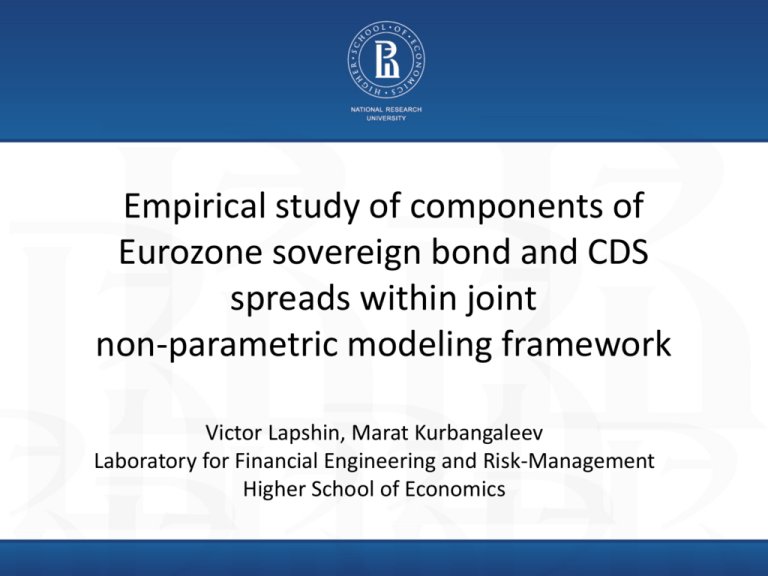Components of Eurozone Sovereign Bond Yield and CDS Spread
advertisement

Empirical study of components of Eurozone sovereign bond and CDS spreads within joint non-parametric modeling framework Victor Lapshin, Marat Kurbangaleev Laboratory for Financial Engineering and Risk-Management Higher School of Economics Problem • Bond yields depend on a wide range of factors. • In practice a number of factors is reduced to 2 or 3 components, such as a zero-coupon yield, a credit risk and a liquidity. • In some cases yields may be decomposed consecutively starting with a zero-coupon yield curve. • In other cases components may not be identified separately, so an additional information on components is required (for example, prices of credit derivatives). This is the case of Eurozone sovereign bond market. 2 Motivation • Decomposition of bond yields in different circumstances/environment may require different methods and information. • Popular models are too primitive to describe complex but plausible curves and inflict errors. • Components may be use for pricing and hedging strategy building. 3 Bootstrapping hazard rates for Greece (20th June 2011) 4 Fitting yield curve for Greek bonds with popular methods (19th April 2011) 5 Literature Review • Reduced-form models – Consecutive estimation • Longstaff et al. (2005): CDS is “pure” credit risk premium. • Chen et al. (2008): liquidity premium is earned by CDS buyer, CDS ask quote is free from liquidity effect. – Simultaneous estimation • Buhler and Trapp (2009): CDS bid and ask quotes are driven by correlated processes. • Econometric models • Calice et al. (2011) follow model-independent approach in measuring credit and liquidity component and use timevarying vector autoregression framework to establish the credit and liquidity spread 6 Contribution • • • • Panel data. Advanced original methodology. Joint estimation procedure. Cross-market liquidity, which is measured by CDS-bond spread, is taken into account, while individual characteristics of liquidity are used as accuracy measures for estimation procedure. 7 Interest Rate and Credit Risk Analogies in Reduced-Form Model • An economic sense dictates the following requirements to discount function d (t , s ) for any t : 1. 2. 3. 4. d (t , s1) d (t , s 2) if s1 s 2 d (t , s ) 0, for s 0 d (t , 0) 1 d (t , s ) 0, with s 0 where t is moment of time and s is term. • In reduced-from models the same properties are required from survival probability function P( t , s ) . 8 Interest Rate and Credit Risk Analogies in Reduced-Form Model • The main object modeled within reduced-form models of interest rates is a term structure of instantaneous forward rates ft ( s ). Discount factor s is: s r (s) f ( ) d d (t , s) e t e t 0 • In context of a credit risk a corresponding object is a term structure of hazard rates t ( s ) , which are in essence a densities of probability to have a default at term s conditional on information available at time t. Hence survival probability is: s P(t , s) e 0 t ( ) d 9 Double HJM Equations • The joint uncorrelated model ~ j d j dr Dr dt t t t t t j 1 ~j j ~ dt ~ d D t d t t t t j 1 gives a nonparametric approach to snapshot yield curve and default intensity fitting. • Infinite-dimensional model is needed because it serves as a guarantee for the approach to be internally consistent and arbitrage-free for use on an everyday basis 10 Joint estimation of hazard rates and interest rate • Find a risk-free spot forward rate curve f(t) and issuer-specific spot hazard rates hi(t) such that: – CDS quotes are fitted with weights proportional to relative liquidity. – Risky bonds prices are fitted with weights proportional to bid-ask spreads. – Fitted curves are sufficiently smooth. 11 Joint estimation of hazard rates and interest rate Optimization problem: f '( )2 d J1k hk ( )2 d J 2k min k where 1 J k k T askT bidT k 1 k k f (·), hk (·) K T k PT d (ti ) Fi ,T Qk (Ti ) 0 (1-LGD)·d ( )d 1 Qk ( ) i 1 Nk ,T 2 N T T k k J 2 wT LGD·d ( )d 1 Qk ( ) sT d (Ti ) (Ti 1, Ti )Qk (Ti ) d ( ) (TI ( ) , )d 1 Qk ( ) 0 T i 1 0 12 2 Data • Eurozone sovereign bonds price data: • Market price • Bid & Ask • Source: Bloomberg • Eurozone sovereign CDS price data: • Conventional spreads / par spreads • Source: Reuters • Issuers: Germany, France, Italy, Spain, Ireland, Greece, Portugal • Time period: March 2010 – June 2011 13 Results (France) 14 Results (Portugal) 15 Results (Portugal) 16 Results (Greece) 17 Results (Greece) 18 Conclusions • Hazard rate term structure indicates two scenarios of evolution of reference entity’s credit quality. • While term structures of risk-free yield and hazard rates have quite regular shapes, the bond-CDS basis which we treat as cross-market liquidity spread evolves in rather non-trivial but pronounced manner. • Liquidity of CDS market dries up from longer tenors with decline in credit quality of reference entity. • Significant liquidity squeeze in CDS market during continuous time span. 19 Acknowledgements • The study was implemented in the framework of the Basic Research Program at the National Research University Higher School of Economics (HSE) in 2012. 20 mkurbangaleev@hse.ru




